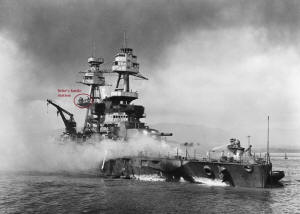|
 Charles achieved his mother’s dream, graduating from Geneva High
in 1940 before enlisting in the Navy. After basic training, his
class was divided into two equal groups of 55 each; the first group
was assigned to the USS Arizona. Sehe, number 56, and the rest of
his class were sent to Bremerton, Washington, where the USS Nevada
was undergoing repairs while in drydock. Charles achieved his mother’s dream, graduating from Geneva High
in 1940 before enlisting in the Navy. After basic training, his
class was divided into two equal groups of 55 each; the first group
was assigned to the USS Arizona. Sehe, number 56, and the rest of
his class were sent to Bremerton, Washington, where the USS Nevada
was undergoing repairs while in drydock.
Sehe’s initial battle station was one of the ship’s 5-inch guns, but
after the slight-framed kid from Geneva dropped a couple of 5-inch
rounds during a drill, he was reassigned. As fate would have it, his
new station was high up on the Nevada’s mast, manning one of the
ship’s searchlights.
A few months later, on a lazy Sunday morning in December, 1941, both
the Arizona and Nevada were moored along battleship row in Pearl
Harbor, Hawaii, as were several other battleships and most of the
Pacific fleet. Sehe’s plan for the weekend had been to take liberty
on Saturday and see the town with a buddy assigned to the USS
Arizona, then spend the night on that battleship. But once again
fate intervened. Sehe was caught drying out his laundry in front of
an exhaust fan, and drew three days kitchen duty for the minor
infraction.

So it was that he was pulling kitchen duty on the USS Nevada on the
morning of December 7th. “Seven o’clock, I got breakfast.
Seven-thirty, I went to the head,” recounted Sehe during a recent
oral history interview. “After the head, [I] washed up, getting
ready for meals, you know? … Then the four or five of us in the head
were sitting around, and all of a sudden, it jarred [us], boom! And
I said, ‘Oh, they’re practicing fire. I ran to my battle station and
oh my God, it was just unbelievable.”
What Sehe had felt was a Japanese torpedo slamming into the side of
the Nevada. What he saw from his battle station was a harbor in
chaos, with wave after wave of Japanese aircraft coming at them from
all directions.
Here is how Sehe described what he saw that day from the ship’s mast
in a letter to family members written 50 years later:
[to top of second column] |


“The Nevada, with some of its boilers already lit on standby, got up
enough steam pressure to get underway. As the ship slowly eased its
way into the channel, passing the Arizona, a tremendous fiery
explosion ripped the Arizona apart, showering the open deck crews of
the Nevada with hot, searing, metallic debris, burning many of them
to death.”
“I watched a second wave of high-level dive bombers now concentrating their
efforts on the Nevada as we slowly proceeded up the channel, and heard cheers
coming from crews of other ships, encouraging us onward,” his letter continued.
“Although there were many near misses, as indicated by numerous waterspouts,
numerous bombs made their mark and severely damaged the forecastle bridge and
the boat deck area. The Nevada was given orders to beach itself so as to avoid
blocking the channel to prevent other ships from entering or leaving.”
Sehe stayed with the Nevada for the rest of the war. After it was rebuilt and
up-gunned, the venerable old battleship and the young man from Geneva saw plenty
more action, including at the Aleutians, Utah Beach, the invasion of southern
France, plus Iwo Jima and Okinawa.
Charles Sehe, now 92 and living in Minnesota, still finds it difficult to share
his memories of the Pearl Harbor attack. Writing about his experiences has been
cathartic, but never easy. One thing he does know, something that is universal
in human affairs: It’s the politicians and statesmen who create the dilemmas
that lead to wars, but it’s always the young men who have to fight them.
-----
Mark DePue is the Director of Oral History at the Abraham Lincoln Presidential
Library and Museum. You can listen to Sehe’s entire story, and those of many
other veterans, at www.oralhistory.illinois.gov.
[Submitted by Chris Wills, Abraham
Lincoln Presidential Library and Museum] |